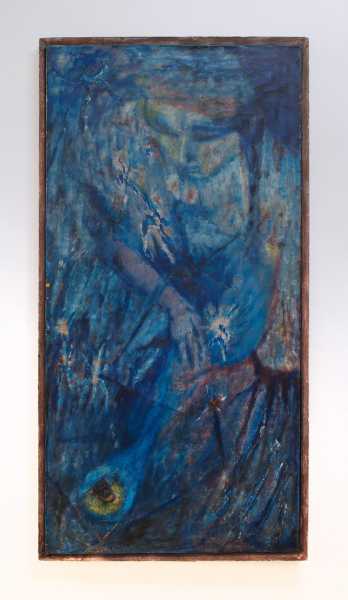
The judge’s daughter, the sculptor’s wife, the elegant neighbor—like many women of her generation, Richanda Rhoden was largely defined by her relationships. But I suspect that she introduced herself as an artist. For decades, Rhoden painted almost every day. After she began using a wheelchair near the end of her life—she died in 2016, just four months shy of her hundredth birthday—she moved the studio to her elevator. Now, at Soloway, an artist-run storefront in South Williamsburg, Rhoden is having what is probably her first solo show—“probably” because Rhoden didn’t maintain an archive, and Emily Weiner, the conscientious thirty-seven-year-old painter who put the show together, just can’t be sure. “She planned to live until she was a hundred and sixteen,” Weiner told me during my recent visit to the gallery, where the kaleidoscopically colored canvases on the walls, made between 1965 and 1985, share the mystical, folkloric leanings of Rufino Tamayo and Marc Chagall, with a compositional undulance all their own.
Weiner met Rhoden in 2011, in Brooklyn Heights, where their studios shared a common wall. Rhoden lived on Cranberry Street, in a converted livery stable, built in 1899, which she and her sculptor husband, John, bought in 1960. (There’s a rumor that Isamu Noguchi had scouted the place, but the Rhodens snapped it up first.) Richanda was a neighborhood legend (and “astonishingly chic,” per her obituary in the Brooklyn Heights Press). She started the Cranberry Street Fair, threw open-armed parties, and was so beloved by her neighbors that they nominated her for a “New Yorker of the Week” segment on the local television news. In fact, her biography is so fascinating that it threatens to eclipse her art.

“Untitled (Woman).”
Artwork by Richanda Rhoden. Courtesy Soloway Gallery
Born in 1917, she was half Cherokee and half Menominee. Her parents met at the Carlisle Indian Industrial School, in Pennsylvania. Her father, James Phillips, who played football alongside Jim Thorpe, went to law school at Northwestern and later became the first Native American judge in Washington State, where Richanda was born. She married her college sweetheart, in Seattle; he died soon after, in the Second World War. Seeking a fresh start, she moved to New York City to pursue a Master’s degree in Asian Art, at Columbia. There, she met John Rhoden, an African-American sculptor from Birmingham, Alabama, and a rising star. Richanda gave up her studies to paint in earnest, perhaps when the couple moved to Italy, for John’s Fulbright Fellowship, in 1951. The Rhodens never had children and travelled extensively—to India, Egypt, Turkey, Indonesia—as a selection of Kodachrome slides at Soloway attest.
Over the next half century, John enjoyed a successful career, with prominent public projects in the U.S. (including at three hospitals in New York City) and international exhibitions. When Weiner met Richanda, the younger artist was organizing exhibitions in the living room of her apartment, but she never worked up the nerve to ask her neighbor to show. “By the time I met her, she had enough friends,” Weiner told me. “As generous as she was with her space, she was suspicious of people she didn’t know.” Why didn’t Richanda have a more public career, aside from the odds being stacked against female artists? Weiner’s theory: “She was such a fierce person, I think she wanted to set her own terms.”
Earlier this year, the Pennsylvania Academy of the Fine Arts acquired John’s estate—about three hundred pieces—and has hired a dedicated curator to oversee it. In 2019, PAFA will open a new art center named in honor of John and Richanda Rhoden, but the legacy of hundreds of Richanda’s paintings remains uncertain. At a time when the story of art is dominated by fame, money, power, and political rhetoric, her show at Soloway is more than a memorial to an overlooked talent—it’s an oasis.
“Richanda Rhoden” at Soloway is open on Saturdays and Sundays through September 23rd. The gallery will be closed over Labor Day weekend.
Sourse: newyorker.com






